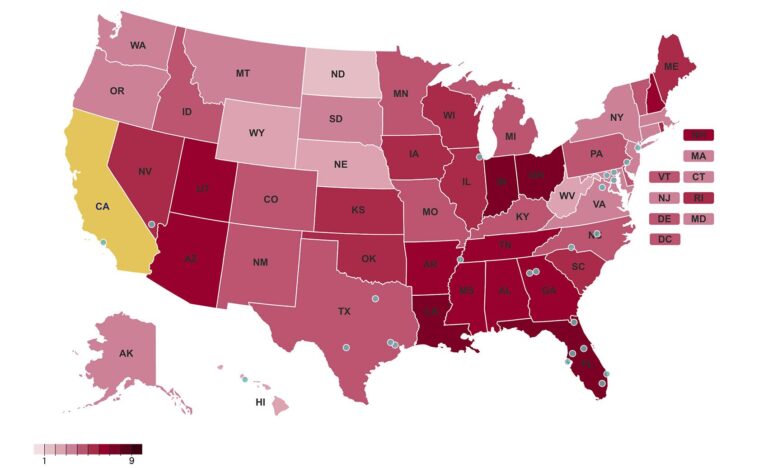Expanding Horizons: How 36% of U.S. Students Now Qualify for School Choice Programs
A recent analysis by the Washington Policy Center highlights a transformative trend in American education: over one-third of students nationwide are now eligible to participate in school choice initiatives. This surge in eligibility signals a growing movement toward diversifying educational options beyond traditional public schools, encompassing charter schools, private institutions, and voucher-supported programs. As debates intensify around the implications of school choice on fairness and academic excellence, this data emphasizes the expanding influence of alternative schooling pathways in shaping student futures across the country.
Understanding the Growth in School Choice Eligibility
The proportion of students qualifying for school choice programs has climbed to 36%, reflecting broader eligibility criteria and increased funding allocations. These programs are designed to empower families by offering alternatives tailored to diverse learning needs and circumstances. Key factors driving this expansion include:
- Economic Eligibility: The largest segment of qualifying students comes from low- and moderate-income households, who gain access to scholarships and voucher programs aimed at reducing financial barriers.
- Special Education Needs: Students requiring specialized instructional environments are increasingly included, ensuring that tailored support is accessible beyond traditional public school settings.
- Geographic Considerations: Eligibility extends to students in rural and underserved urban areas, where educational resources may be limited, broadening opportunities for quality alternatives.
| Eligibility Category | Percentage of Students | Representative States |
|---|---|---|
| Income-Based | 22% | Georgia, Nevada |
| Special Needs | 8% | Illinois, Michigan |
| Location-Based | 6% | Vermont, New Mexico |
As these programs evolve, education leaders stress the necessity of vigilant oversight to guarantee that expanded access translates into equitable and high-quality learning experiences. Balancing innovation with accountability remains a central challenge for policymakers aiming to serve diverse student populations effectively.
Evaluating the Effects of Broadened Eligibility on Educational Fairness
The increase in students eligible for school choice programs represents a pivotal shift in educational access. Proponents highlight that this expansion offers historically marginalized groups‚ÄĒsuch as economically disadvantaged families and minority students‚ÄĒgreater opportunities to escape underperforming schools and find environments better suited to their needs. This could contribute to narrowing achievement disparities by providing customized educational pathways.
However, skeptics caution that without careful policy design, these initiatives might unintentionally deepen inequities by diverting essential funding from traditional public schools, which continue to educate the majority of students. Key considerations include:
- Broader Access: Families now have more options, including charter schools, private academies, and homeschooling, fostering educational diversity.
- Financial Pressures: Public school districts may experience enrollment declines, leading to budget constraints and potential program cuts.
- Quality Assurance: Maintaining consistent standards and equitable outcomes across a growing array of school choice options remains complex.
| Indicator | Pre-Expansion | Post-Expansion |
|---|---|---|
| Student Eligibility (%) | 22% | 36% |
| Public School Enrollment Decline (%) | ‚ÄĒ | 4.5% |
| Funding for Choice Programs (USD) | $1.2 Billion | $2.3 Billion |
Long-term data tracking is essential to assess whether these expanded opportunities lead to improved graduation rates, higher standardized test scores, and enhanced student well-being. Policymakers must carefully weigh the benefits of parental choice against the need to sustain robust public education systems, ensuring that reforms uplift all learners without unintended setbacks.
Public and Private Schools: Navigating New Realities and Possibilities
Challenges Facing Public Schools
As school choice eligibility broadens, public schools confront intensified competition for student enrollment and funding. This environment compels districts to innovate in curriculum design, resource management, and community engagement to remain attractive to families. Equity concerns also rise, as resource redistribution may disproportionately affect schools serving vulnerable populations.
- Declining enrollment impacts budget stability.
- Pressure to enhance academic offerings and extracurricular programs.
- Need to address equity gaps amid shifting demographics.
Opportunities for Private Schools
Private institutions stand to benefit from expanded school choice policies by attracting a more diverse student body and experimenting with innovative teaching methods. However, they must also tackle challenges related to affordability and inclusivity to fully capitalize on these opportunities. Partnerships with public entities could foster shared solutions to educational disparities.
- Growth potential through voucher and scholarship programs.
- Ability to implement personalized and flexible curricula.
- Necessity to balance quality with accessibility.
| Public School Challenges | Private School Opportunities |
|---|---|
| Budget reductions due to enrollment shifts | Flexible tuition and financial aid models |
| Addressing equity for marginalized students | Expanded access via scholarships and vouchers |
| Resistance to systemic change | Innovative curricula and personalized learning models |
Strategic Policy Measures to Strengthen School Choice Access and Excellence
To harness the full potential of school choice programs, policymakers must enact comprehensive strategies that promote fairness, transparency, and quality. Expanding financial assistance through vouchers and tax incentives can reduce economic barriers for families. Additionally, enhancing data transparency regarding school performance empowers parents to make well-informed decisions aligned with their children’s needs.
Recommended policy initiatives include:
- Establishing uniform accountability standards across all educational institutions participating in choice programs.
- Increasing targeted funding for schools serving historically underserved communities to close opportunity gaps.
- Investing in continuous professional development for educators within choice schools to uphold instructional excellence.
- Developing streamlined, user-friendly digital platforms for application and enrollment processes.
| Policy Focus | Action Steps |
|---|---|
| Funding | Broaden voucher eligibility with sliding scale income criteria |
| Access | Implement centralized digital enrollment systems |
| Accountability | Mandate standardized reporting of academic and operational outcomes |
| Quality | Support ongoing teacher training and certification programs |
Final Thoughts: Navigating the Future of School Choice in America
The expansion of school choice eligibility to encompass 36% of U.S. students marks a pivotal moment in the nation’s educational evolution. This development opens doors to new possibilities for families seeking tailored learning environments while simultaneously posing complex challenges for public and private schools alike. As stakeholders continue to deliberate on the balance between access, equity, and quality, the insights from the Washington Policy Center serve as a crucial guidepost. The coming years will reveal how these expanded options reshape enrollment trends, student achievement, and the broader educational ecosystem across the United States.







